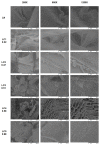Fungal Exocellular (1-6)-β-d-glucan: Carboxymethylation, Characterization, and Antioxidant Activity
- PMID: 31083511
- PMCID: PMC6539860
- DOI: 10.3390/ijms20092337
Fungal Exocellular (1-6)-β-d-glucan: Carboxymethylation, Characterization, and Antioxidant Activity
Abstract
Exocellular (1→6)-β-d-glucan (lasiodiplodan) produced by the fungus Lasiodiplodia theobromae MMPI was derivatized by carboxymethylation using different concentrations of a derivatizing agent. Lasiodiplodan was derivatized by carboxymethylation in an attempt to increase its solubility and enhance its biological activities. Carboxymethylglucans with degrees of substitution (DS) of 0.32, 0.47, 0.51, 0.58, and 0.68 were produced and characterized. FTIR analysis showed a band of strong intensity at 1600 cm-1 and an absorption band at 1421 cm-1, resulting from asymmetric and symmetrical stretching vibrations, respectively, of the carboxymethyl group COO- in the carboxymethylated samples. Thermal analysis showed that native lasiodiplodan (LN) and carboxymethylated derivatives (LC) exhibited thermal stability up to 200-210 °C. X-ray diffractometry demonstrated that both native and carboxymethylated lasiodiplodan presented predominantly an amorphous nature. Scanning electron microscopy revealed that carboxymethylation promoted morphological changes in the biopolymer and increased porosity, and alveolar structures were observed along the surface. The introduction of carboxymethyl groups in the macromolecule promoted increased solubility and potentiated the hydroxyl radical-scavenging activity, suggesting a correlation between degree of substitution and antioxidant activity.
Keywords: bioactive macromolecules; biopolymer; carbohydrate; exopolysaccharide; lasiodiplodan.
Conflict of interest statement
The authors declare no conflict of interest.
Figures






References
-
- Cunha M.A.A., Albornoz S.L., Santos V.A.Q., Sanchez W.N., Barbosa-Dekker A.M., Dekker R.F.H. Structure and biological functions of d-glucans and their applications. In: Atta-ur-Rahmanc, editor. Studies in Natural Products Chemistry. 53rd ed. Vol. 53. Elsevier; Amsterdam, The Netherlands: 2017. pp. 309–333.
MeSH terms
Substances
LinkOut - more resources
Full Text Sources
Medical

